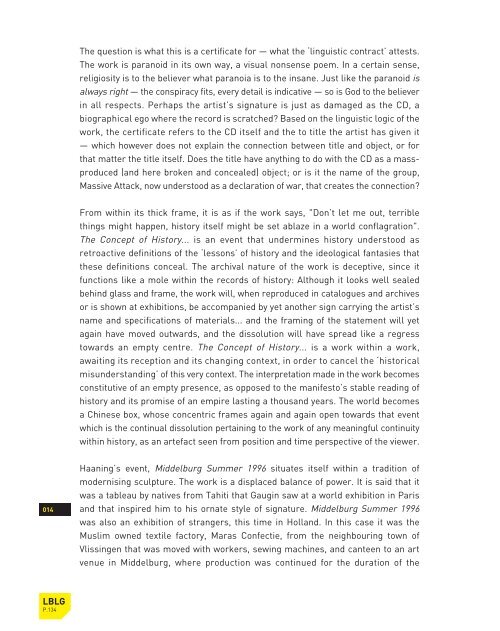download catalogue high resolution pdf (22.3 mb) - Jens Haaning
download catalogue high resolution pdf (22.3 mb) - Jens Haaning
download catalogue high resolution pdf (22.3 mb) - Jens Haaning
Create successful ePaper yourself
Turn your PDF publications into a flip-book with our unique Google optimized e-Paper software.
014<br />
LBLG<br />
P.134<br />
The question is what this is a certificate for — what the ‘linguistic contract’ attests.<br />
The work is paranoid in its own way, a visual nonsense poem. In a certain sense,<br />
religiosity is to the believer what paranoia is to the insane. Just like the paranoid is<br />
always right — the conspiracy fits, every detail is indicative — so is God to the believer<br />
in all respects. Perhaps the artist’s signature is just as damaged as the CD, a<br />
biographical ego where the record is scratched? Based on the linguistic logic of the<br />
work, the certificate refers to the CD itself and the to title the artist has given it<br />
— which however does not explain the connection between title and object, or for<br />
that matter the title itself. Does the title have anything to do with the CD as a massproduced<br />
(and here broken and concealed) object; or is it the name of the group,<br />
Massive Attack, now understood as a declaration of war, that creates the connection?<br />
From within its thick frame, it is as if the work says, "Don’t let me out, terrible<br />
things might happen, history itself might be set ablaze in a world conflagration".<br />
The Concept of History... is an event that undermines history understood as<br />
retroactive definitions of the ‘lessons’ of history and the ideological fantasies that<br />
these definitions conceal. The archival nature of the work is deceptive, since it<br />
functions like a mole within the records of history: Although it looks well sealed<br />
behind glass and frame, the work will, when reproduced in <strong>catalogue</strong>s and archives<br />
or is shown at exhibitions, be accompanied by yet another sign carrying the artist’s<br />
name and specifications of materials... and the framing of the statement will yet<br />
again have moved outwards, and the dissolution will have spread like a regress<br />
towards an empty centre. The Concept of History... is a work within a work,<br />
awaiting its reception and its changing context, in order to cancel the ‘historical<br />
misunderstanding’ of this very context. The interpretation made in the work becomes<br />
constitutive of an empty presence, as opposed to the manifesto’s stable reading of<br />
history and its promise of an empire lasting a thousand years. The world becomes<br />
a Chinese box, whose concentric frames again and again open towards that event<br />
which is the continual dissolution pertaining to the work of any meaningful continuity<br />
within history, as an artefact seen from position and time perspective of the viewer.<br />
<strong>Haaning</strong>’s event, Middelburg Summer 1996 situates itself within a tradition of<br />
modernising sculpture. The work is a displaced balance of power. It is said that it<br />
was a tableau by natives from Tahiti that Gaugin saw at a world exhibition in Paris<br />
and that inspired him to his ornate style of signature. Middelburg Summer 1996<br />
was also an exhibition of strangers, this time in Holland. In this case it was the<br />
Muslim owned textile factory, Maras Confectie, from the neighbouring town of<br />
Vlissingen that was moved with workers, sewing machines, and canteen to an art<br />
venue in Middelburg, where production was continued for the duration of the


